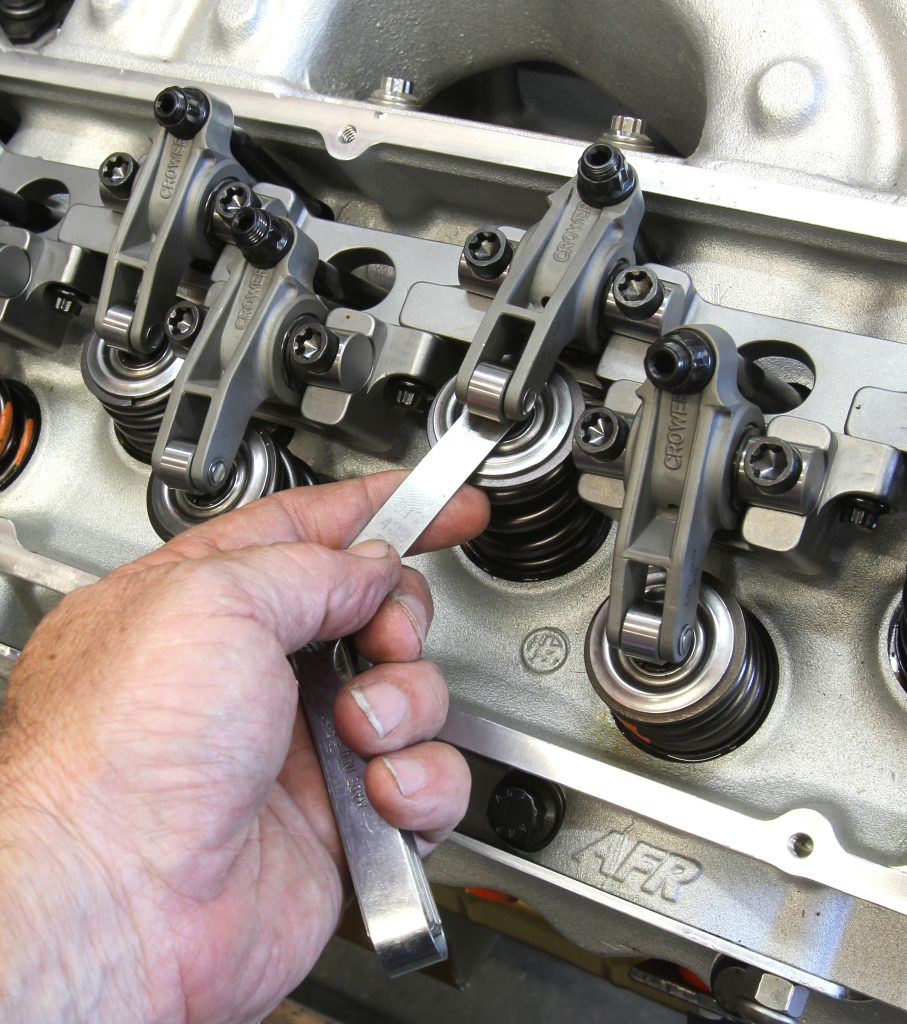I have a question about my 496ci big block Chevy with a Comp mechanical roller cam. The card tells me that the lash (hot) is supposed to be 0.020 inch on the intake and 0.022 inch on the exhaust. I’ve heard that I can change the lash to make more power, but I don’t really understand how this works. Thanks
T.M.
***
Lash is the clearance between the rocker arm tip and the top of the valve with a spec provided by the cam manufacturer usually indicated as a “hot” clearance once the engine has achieved normal operating temperature.
We’ll look at the intake side for this explanation but the same idea applies to the exhaust side. The spec for you intake side is 0.020 inch. If we reduce the clearance, this will open the valve intake valve sooner and closer it later measured in crankshaft degrees.
Of course the opposite is also true. If you increase the lash, the intake valve opening point will be delayed slightly and the closing point will occur sooner. This combination will essentially make the camshaft operate as if it had shorter duration. Any lash change also has an effect on valve lift—although again only a slight amount.
Valve Lash & Its Impact on Duration
Let’s say that you tighten the lash to 0.018 inch. This will increase the duration by a small amount on both ends. Let’s estimate that this opens the intake valve one degree sooner and closes the intake valve one degree later. The closing side of the lobe is often designed to slow the valve down before it hits the seat to prevent the valve from bouncing at high rpm. This means that it often delivers more duration on the closing side if the lash is tightened than what you may see on the opening side.
If your camshaft was listed as having 280 degrees of duration at the advertised spec of 0.006 inch tappet lift, we could assume that the cam will now be closer to 282 degrees of duration. Most cam companies offer opening and closing points at 0.050 inch tappet measuring points which is not affected by the change in lash.
The only way to know the exact amount of increase in duration will be to measure the duration with the original lash number by measuring the beginning of lift (say 0.006 inch) on the valve. Then decrease the lash and measure this again. This will require you to set up the degree wheel on the engine exactly the same way you would degree a cam.
It’s also possible that once you go through all this work, you may not see any appreciable change in the duration because the lash change was so small. This other issue is that each cam lobe family will have a specific ratio of lift per degree of camshaft rotation. This makes any estimate of how much change in duration you will see for a change in lash difficult to answer accurately.
If we had to put a rough number on this approach, we might see a one degree of duration change for roughly a 0.001 inch of change in lash. So a 0.004 inch decrease in lash would then mean roughly a four degree increase in duration.
But that is not an etched in stone situation—every family of mechanical cam lobe will respond differently.

Changing Lash from Factory Spec
The next question would then be how much you can change the lash from the factory spec. Again, this will be different between older camshafts with wide lash specs and more modern cams that are so-called “tight lash” cams. The older cams can probably accommodate 0.004 inch tighter and 0.006 inch looser for a total range of testing of 0.010 inch.
Based on the above estimate, that’s a 10 degree total swing in duration which is fairly wide. Tight lash cams start with a smaller lash but the range would be similar with 0.004 to 0.005 inch tighter and 0.006 inch looser.
Changing lash is one way to determine what your engine wants in terms of overall valve duration. Evaluating the results of this change is a bit more complicated. The best way would be on an engine dyno. Increasing duration by tightening the lash will tend to decrease torque below the torque peak rpm point and increase horsepower above peak torque. The opposite is also true by shortening duration by loosening the lash.
Valve Lash & Engine Power
If you don’t have access to an engine dyno, you can evaluate the power change by running the car on the drag strip. If after changing the lash the finish line mph improves, then the engine wants the change in lash and you might change it slightly in that same direction.
Keep in mind that if the engine has a cam that is too long in duration, increasing lash will shorten the duration, which might improve the torque below torque peak. This may improve the vehicle’s acceleration, which should show up as an increase in mph trap speed.
Of course, if the mph drops, then you know that the change was not a positive move.
A Word of Caution…
Finally, if you tighten the lash with the engine fully warmed up always check to make sure there is some lash in the valvetrain with the engine cold. What you don’t want to do is over-tighten the lash which might hold the valve open off the seat when the engine cools down completely.
This can occur on engines with both aluminum blocks and heads. So double check this change when cooled off.
If the engine runs with the valves off the seat when cold, this can kill an exhaust valve very quickly, so be careful with your lash adjustments.

Comments